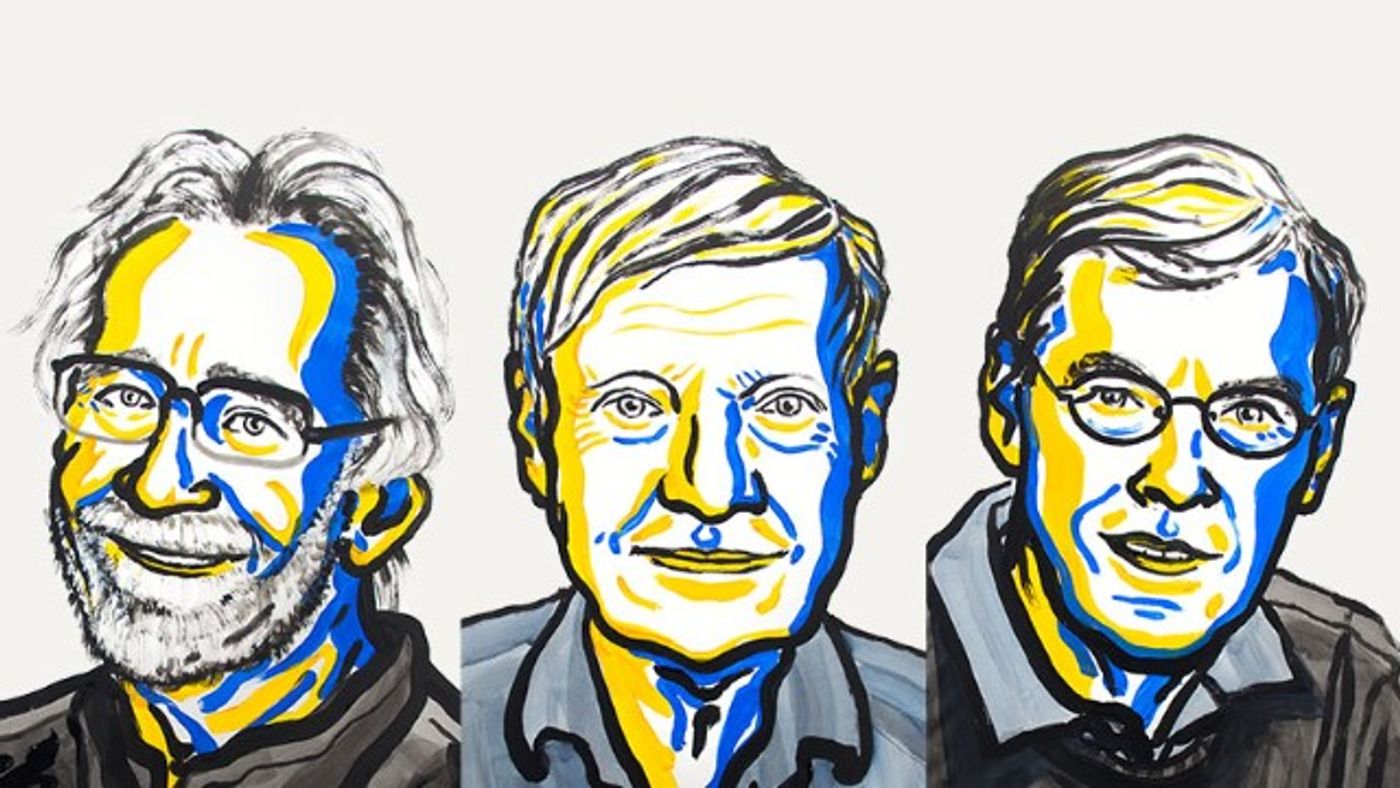Chemistry Nobel 2017 - Why Cryo-Electron Microscopy
Chemistry Nobel Laureate Jacques Dubochet, Joachim Frank, and Richard Henderson. Credit: The Royal Swedish Academy of Sciences
Long before the actual announcement, many in science have been discussing the question “who will take home the Chemistry Nobel this year”. At the top of the prediction list are John B. Goodenough and collaborators who helped develop lithium-ion batteries, Harry B. Gray who solved a wide range of fundamental problems in bioinorganic chemistry, biophysics, and photochemistry, Darleane C. Hoffman whose contributions to nuclear chemistry changed the field, as well as the trio of Jennifer Doudna, Emmanuel Charpentier, and Feng Zhang who pioneered CRISPR/Cas9 gene-editing technology.
When the official announcement came out last week - the trio of Jacques Dubochet, Joachim Frank, and Richard Henderson was awarded for “developing cryo-electron microscopy (Cryo-EM) for the high-resolution structure determination of biomolecules in solution”, many felt surprised. It is hard to associate the advancement in chemistry has anything to do with a microscopy-type method. But looking back to the history of Chemistry Nobel and the progress made in biochemistry, this is not the first time the world’s most prestigious award has paid tribute to those image biomolecules like nucleic acids and proteins. Before Cryo-EM came along, biologists relied heavily on nuclear magnetic resonance (NMR) spectroscopy and x-ray crystallography to zoom in on biomolecules. Despite their widespread application, two popular methods are not without pitfalls: NMR spectroscopy has a limit on the size of study molecule, while x-ray crystallography requires the molecule to crystallize (proved impossible for some) before the examination. Electron microscopy provides an excellent alternative: it utilizes electron beam instead of light to magnify samples to atomic resolution. But both the bombardment of intense electrons and the vacuum working environment of the electron microscope are quite destructive to most biomolecules.
What Henderson did in 1975 served as the proof of principle for Cyro-EM. He and his team from MRC Laboratory of Molecular Biology managed to come up with a three-dimensional model of bacteriorhodopsin using electron microscopy. There were a few smart moves behind the success: the use of low-intensity electron beam, keeping the protein in its native lipid environment, protecting the sample with glucose solution, and averaging multiple images. This ground-breaking study proved that electron microscopy could capture as clear an image of a biomolecule as crystallography, the benchmark method back then.
Over the next 15 years, the technique underwent a major improvement - the addition of liquid nitrogen to fast freeze study samples and protect them from the harsh electron beam and dehydration in the vacuum. This led to the name cryo-electron microscopy. But ice crystals which form during rapid freezing process disrupted the electron beams so much that the images could be rendered useless. The vitrification of water, a process that cools down water so rapidly it forms a glass instead of ice crystals, could solve the problem. Because in vitrified water molecules are in random order; unlike crystal, they do not interfere with imaging. In 1982 Dubochet and colleague found that they could vitrify water by adding ethane that had been chilled by liquid nitrogen. Their revised cooling method eliminated another roadblock toward high-resolution imaging.
Not very long after, Frank at the New York State Department of Health Wadsworth Center, developed an image-processing technology that allows computer to convert conventional fuzzy 2-D electron microscopy images of a single molecule into a 3-D structure.
Structures of glutamate dehydrogenase under cryo-EM, with increasing resolution from left to right. Credit: Martin Högbom/Stockholm University
In the past five years, thanks to the advances in electron-detection technology, particularly the development of direct electron detectors, cryo-EM’s resolution improved significantly. The advent of these detectors alongside with improvements in data-handling techniques revolutionize in the quality of the data. Cryo-EM has been used to capture the structure all sorts of complex proteins, even the Zika virus during the recent outbreak in Brazil.
According to the president of the American Chemical Society Allison Campbell, the Chemistry Nobel being awarded to the development of Cryo-EM made perfect sense. She explained: “To me, this is all about chemistry because this (technique) enables us as scientists to look at molecules and the arrangement of atoms in molecules and the resulting structures. And that’s all about chemistry. It doesn’t really matter that it’s a biomolecule. It’s how that molecule is interacting with its environment other molecules, which is important. To me, this is all about chemistry”. Because its exciting potential for advancing and revolutionizing structural biology and drug development, the National Institutes of Health called cryo-electron microscopy its “method of the year” in 2016.
The 2017 Nobel Prize in Chemistry: Cryo-electron microscopy explained. Credit: C&EN










